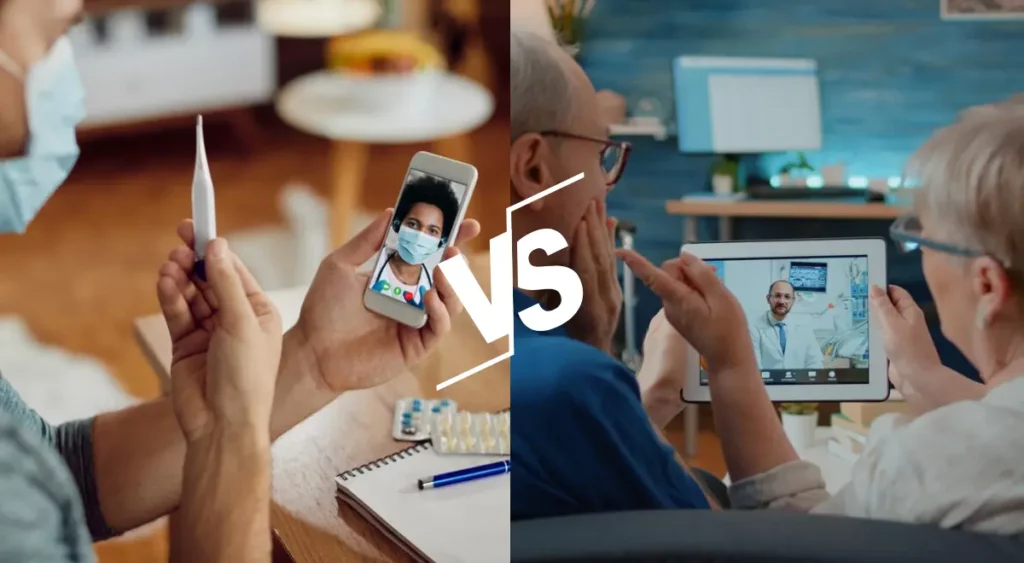Remote Patient Monitoring (RPM) vs. Remote Therapeutic Monitoring (RTM)

Remote Patient Monitoring (RPM) tracks vitals like blood pressure and glucose, while Remote Therapeutic Monitoring (RTM) focuses on therapy and adherence data. Knowing the difference helps providers choose the right program for care delivery and reimbursement.
Planning to adopt remote care technology at your healthcare practice, but don’t know which one to prefer? If you are choosing between Remote Patient Monitoring (RPM) and Remote Therapeutic Monitoring (RTM), there are so many factors that can help you decide which one is relevant for you and your patients. Though both of them allow monitoring the patients from the comfort of their homes, there are still many aspects that differentiate them from each other.
From healthcare professionals who can implement them to the type of data collection and conditions covered, RPM and RTM have their own protocols, codes, reimbursements, and procedures.
Table of Contents
ToggleOverview of Remote Patient Monitoring (RPM)
Remote Patient Monitoring, also known as remote physiologic monitoring was introduced in 2019 by the Centers for Medicare & Medicaid Services (CMS). It refers to the technology or procedure that allows monitoring chronically ill patients outside of a clinical setting. To bill a patient for RPM CPT Codes, the data collected should include physiologic data like heart rate, pulse rate, blood pressure, oxygen level, glucose readings, etc.
Physician/ QHCP can bill for RPM services and care staff can monitor under their supervision. Also, the patient data is transmitted directly to the healthcare provider via WiFi or cellular-based remote monitoring devices.
In short, key RPM points include:
- Captures Physiological Data
- Covers Post Acute & Chronic Conditions
- Data Transmitted Automatically
- Billed By Physicians, Non-physician Providers, including PAs & NPs
Overview of Remote Therapeutic Monitoring (RTM)
Proposed on July 7, 2022, Remote Therapeutic Monitoring (RTM) was finalized by CMS on November 1, 2022 and allows healthcare providers to monitor non-physiological data from a remote setting. RTM services focus on musculoskeletal and respiratory systems, therapy adherence, and therapy response. It is designed to monitor non-physiological data in response to signs, symptoms, and functions of a therapeutic response.
To bill a patient for RTM CPT Codes, the data collected should include non-physiological parameters like pain, fatigue, energy, inflammation, exercise capacity, energy, sleep, weight loss/ gain, anxiety, depression.
In short, key RTM points include:
- Captures Non-Physiological Data
- Covers Musculoskeletal, Respiratory, & Patients’ Adherence and Response to Cognitive Behavioral Therapy (CBT)
- Patient Self-Report Non-physiological Parameters
- Billed By Physicians, Non-physician Providers, including PTs, OTs & SLPs
Difference Between RPM & RTM Scope of Monitoring
After the COVID-19 pandemic, healthcare providers were left thinking about whether they should consider implementing remote care models at their practice to deliver quality care to patients, right from their homes.
Centers for Medicare & Medicaid Services (CMS) recognized the need to implement remote care programs such as RPM and RTM and expanded its reimbursement prospects with the release of new Current Procedural Terminology (CPT) codes for RTM in 2022.
When it comes to comparison, Remote Patient Monitoring is a means of remotely monitoring patients by automatic transmission of data from their FDA approved medical devices to the clinician monitored RPM platform. This can be done in real time or at regular intervals, depending on the patient’s specific needs and condition.
Whereas, Remote Therapeutic Monitoring enables clinicians to remotely monitor their patients’ non-physiological data with a focus on therapy adherence and therapy response specific to the musculoskeletal and respiratory systems; and patient adherence and response to cognitive behavioral therapy.
RPM vs. RTM, what really separates the two? While RPM is primarily about monitoring physiological data, RTM is more about tracking therapeutic progress and adherence to treatment plans.
| Category | Remote Patient Monitoring (RPM) | Remote Therapeutic Monitoring (RTM) |
|---|---|---|
| Purpose | Monitors physiological data such as vitals. | Monitors therapy progress, adherence, and patient-reported data. |
| Data Tracked | Blood pressure, glucose, oxygen, weight, heart rate. | Medication adherence, pain levels, musculoskeletal/respiratory health. |
| Devices / Tools | Requires FDA-approved medical devices. | Uses non-clinical devices, mobile apps, or software. |
| CPT Codes | 99453, 99454, 99457, 99458 | 98975, 98976, 98977, 98980, 98981 |
| Best For | Patients with chronic conditions (e.g., diabetes, hypertension). | Medicare in therapy, rehab, or adherence challenges. |
| Reimbursement | Medicare & commercial payers; device validation required. | Medicare reimbursed; fewer device restrictions. |
| Care Model | Continuous vitals monitoring. | Monitors engagement and behavior. |
Difference Between RPM & RTM CPT Codes
When it comes to CPT codes, both RPM and RTM differs a lot. While RPM codes are evaluation/ management codes billed by physicians or qualified healthcare providers, RTM codes are general medicine codes and billed by physical therapists, clinical psychologists, speech-language pathologists, and occupational therapists.
RPM codes apply to wider use cases and health conditions, while the scope of RTM codes is limited to musculoskeletal and respiratory systems; and cognitive behavioral therapy (CBT).
The Bottom Line
As the remote healthcare model continues to evolve, it is critical for healthcare providers planning to improve patient care and reimbursements to understand the difference between RPM and RTM.
Despite some similarities, both these technologies differ a lot in terms of scope and coverage. Whether to go with Remote Patient Monitoring or Remote Therapeutic Monitoring completely depends on the needs and goals of a healthcare provider.
Try HealthArc To Streamline RPM & RTM Services
HealthArc has made significant advancements in the remote healthcare industry by utilizing Remote Patient Monitoring (RPM) and Remote Therapeutic Monitoring (RTM) technology. Our platform combines data from over 40 medical devices, including cellular, Bluetooth, and wearable technologies, to ensure continuous patient monitoring.
Our AI-powered clinical platform improves monitoring efficiency while maintaining strict data security standards and HIPAA compliance.
Schedule a demo today to find out how our platform works or call us today at (201) 885 5571 to create a personalized RPM and RTM solution for your organization.
Key Takeaways
- RPM = vitals monitoring; RTM = therapy & adherence tracking.
- RPM is ideal for chronic conditions, RTM for therapy management.
- Billing differs—RPM uses FDA-approved devices; RTM leverages software/apps.
- Practices can combine RPM + RTM for a complete care model.
- HealthArc unifies both with a single, AI-powered platform.
Frequently Asked Questions (FAQs)
RPM monitors vitals such as blood pressure, oxygen, and glucose, while RTM tracks therapy-related data like adherence, pain, or recovery.
Patients with chronic conditions like hypertension, diabetes, or COPD benefit most from continuous vitals monitoring.
HealthArc’s platform combines RPM and RTM operations, making it easy to connect devices, automate compliance, and bill customers.
RPM requires FDA-approved medical devices and covers physiological monitoring. RTM uses non-clinical devices/apps and is billed under different CPT codes.
Yes. Many providers combine RPM and RTM to cover both vitals monitoring and therapy adherence for comprehensive care.
HealthArc’s platform combines RPM and RTM operations, making it easy to connect devices, automate compliance, and bill customers.
Most Recent Blogs
Categories
Related Blog
- November 26, 2025 | Read Time: 14 mins
Return on Investment (ROI) of Remote Patient Monitoring (RPM): A Complete Guide for ACOs and Healthcare Organizations
The U.S. healthcare system continues its transition from fee-for-service models to value-based...
Learn More- November 24, 2025 | Read Time: 15 mins
Common RPM Pricing Models for Providers: A Profitability-Focused Guide
Remote Patient Monitoring (RPM) has rapidly emerged as one of the leading...
Learn More- October 23, 2025 | Read Time: 12 mins
How RPM Devices Improve Hypertension and Diabetes Outcomes in Medicare Populations
Remote patient monitoring (RPM) is transforming chronic care for Medicare beneficiaries. CMS...
Learn More


